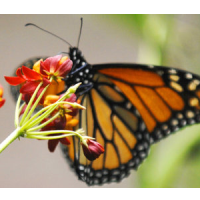Public-Private Partnership Tries to Save Monarch Butterflies as Population Collapses by 970 Million in 25 Years
 Monarch butterfly feeding on a milkweed plant (photo: Steve Smedley, Pantagraph via AP)
Monarch butterfly feeding on a milkweed plant (photo: Steve Smedley, Pantagraph via AP)
Federal wildlife officials are teaming up with two environmental groups to save the monarch butterfly, which has suffered catastrophic losses over the past 25 years.
The U.S. Fish and Wildlife Service (FWS) announced this week that the population of the butterflies has fallen by about 970 million since 1990. The species, which once numbered in the billions across America, is now down to about 30 million, biologists say.
A big reason for the die-off is the disappearance of the milkweed plant, which farmers have destroyed in large numbers while spraying Roundup-ready crops with herbicides. The milkweed is both a food source and a home for the monarch, and without it, the butterflies are struggling to survive.
Roundup, a brand of glyphosate sold by Monsanto, is particularly lethal to milkweed. It kills the plant at the root, preventing regeneration. Farmers use the herbicide widely in tandem with specially engineered crops that are immune to Roundup’s poison, according to a report (pdf) from the Center for Food Safety.
That problem could be exacerbated when farmers are able to use even more herbicides, including 2,4-D, when advanced genetically engineered seeds come along. That substance not only kills the monarchs’ habitat but is lethal to the butterflies themselves.
In an attempt to save the species, FWS has formed a public-private partnership the National Wildlife Federation (NWF) and the National Fish and Wildlife Foundation (NFWF) to replant milkweed across large parts of the country.
The Fish and Wildlife Service will allocate $2 million for the effort while the NWF will conduct public outreach to inform Americans about the need for milkweed. NFWF will focus on fundraising efforts to solicit donations from other private organizations.
The agency will also spend money to plant milkweeds along 200,000 acres of habitat near Interstate 35 from Texas to Minnesota, along the route where about half of the monarchs migrate.
FWS is also considering whether to declare the monarchs an endangered species, which the Center for Biological Diversity has requested.
-Noel Brinkerhoff, Steve Straehley
To Learn More:
The Monarch Massacre: Nearly a Billion Butterflies have Vanished (by Darryl Fears, Washington Post)
Monarchs in Peril (Center for Food Safety) (pdf)
- Top Stories
- Unusual News
- Where is the Money Going?
- Controversies
- U.S. and the World
- Appointments and Resignations
- Latest News
- Musk and Trump Fire Members of Congress
- Trump Calls for Violent Street Demonstrations Against Himself
- Trump Changes Name of Republican Party
- The 2024 Election By the Numbers
- Bashar al-Assad—The Fall of a Rabid AntiSemite






Comments